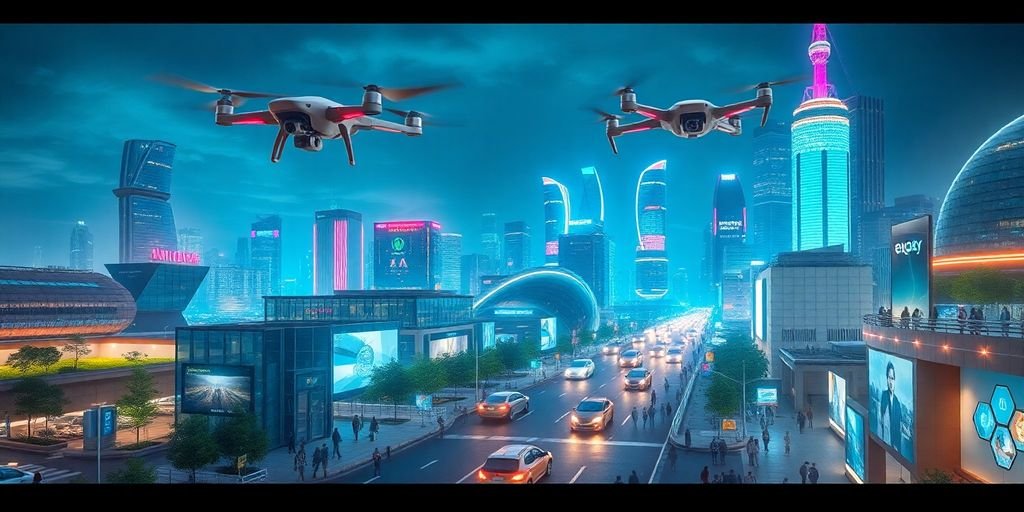As we look towards 2025, the landscape of technology is set to undergo significant transformations. Unique tech innovations are not just on the horizon; they are already shaping our daily lives and will continue to do so in the coming years. From the rise of generative AI to breakthroughs in quantum computing, these advancements promise to alter how we work, communicate, and interact with the world around us. In this article, we will explore some of the most exciting tech trends that are expected to redefine our future.
Key Takeaways
- Generative AI will revolutionise content creation and personalisation.
- Quantum computing will tackle complex challenges and enhance security.
- Autonomous vehicles will improve safety and integrate with urban infrastructure.
- Augmented reality will transform education, retail, and remote work experiences.
- Sustainable tech innovations will drive green energy solutions and reduce waste.
The Rise Of Generative AI

Generative AI is everywhere right now, and it’s only going to get bigger. By 2025, it’s predicted to be a massive part of how we do, well, pretty much everything. We’re talking about AI that can create things – text, images, music, even code. It’s not just about making things faster; it’s about opening up new possibilities we haven’t even thought of yet. It’s a bit mind-blowing, to be honest.
Transforming Content Creation
Forget writer’s block. Generative AI is changing how content is made. Need a blog post? A marketing campaign? AI can do it. It’s not perfect, of course, but it’s getting scarily good. This means businesses can produce more content, faster, and potentially at a lower cost. It also means that the line between human-created and AI-created content is getting blurrier all the time. It’s a wild west out there in the content creation world.
Enhancing Personalisation
We all want things tailored to us, right? Generative AI is making that easier than ever. Imagine ads that are actually relevant, or learning experiences that adapt to your specific needs. That’s the power of AI-driven personalisation. It can analyse data and create experiences that feel like they were made just for you. It’s a bit creepy, maybe, but also pretty cool. Think about the possibilities for digital identity verification.
Revolutionising Customer Interactions
Customer service is getting a serious upgrade thanks to generative AI. Chatbots are becoming more intelligent, able to understand complex queries and provide helpful responses. This means faster support, 24/7 availability, and a better overall experience for customers. It also frees up human agents to deal with more complicated issues. It’s a win-win, in theory, but we’ll see how it plays out in practise. I’m still waiting for a chatbot that can actually understand my sarcasm.
Generative AI is not just a tool; it’s a partner. It can help us be more creative, more efficient, and more innovative. But it’s important to remember that it’s still just a tool. It’s up to us to use it responsibly and ethically. The expected Generative AI Market Size is projected to reach $667.9 bn by 2030. That’s a lot of money.
Quantum Computing Breakthroughs
Quantum computing is still a bit of a head-scratcher for most of us, but it’s making some serious strides. We’re not quite at the point where everyone has a quantum computer on their desk, but the progress is undeniable. It’s like watching a really slow-motion rocket launch – you know it’s going to be big, but it takes time to get off the ground. The potential applications are mind-blowing, and that’s what keeps everyone so excited.
Solving Complex Problems
Quantum computers have the potential to tackle problems that are simply impossible for regular computers. Think about things like optimising logistics, designing new materials, or cracking really tough encryption. The sheer processing power of quantum systems could revolutionise these fields. It’s like going from using an abacus to having a super-powered calculator – the difference is that dramatic. This could lead to breakthroughs in areas we can’t even imagine yet. For example, quantum computers could help design new drugs or create more efficient energy sources.
Impact on Cryptography
One of the biggest concerns (and opportunities) with quantum computing is its impact on cryptography. Current encryption methods, which keep our online data safe, could be vulnerable to quantum attacks. This means we need to develop new, quantum-resistant encryption techniques to stay ahead of the game. It’s a bit of a cat-and-mouse situation, with cryptographers working hard to protect our data from potential quantum threats. It’s not all doom and gloom, though – quantum computing could also lead to even stronger encryption methods in the future.
Advancements in Drug Discovery
Drug discovery is a long and expensive process, but quantum computing could speed things up significantly. By simulating molecular interactions with incredible accuracy, quantum computers could help researchers identify promising drug candidates much faster. This could lead to new treatments for diseases that are currently difficult or impossible to treat. It’s like having a super-powered microscope that lets you see exactly how drugs interact with the body.
Quantum computing is still in its early stages, but the potential benefits are so huge that it’s worth investing in. We need to keep pushing the boundaries of what’s possible, even if it takes time to see the full results. The future could be very different thanks to these advancements.
The Evolution Of Autonomous Vehicles
Autonomous vehicles are no longer a thing of science fiction; they’re rapidly becoming a reality. By 2025, we’re set to see even more advancements in this area, moving beyond just concept cars to practical, everyday applications. It’s not just about self-driving cars either; the whole ecosystem around them is evolving, from infrastructure to regulations. The Autonomy Leaderboard’s Q2 2025 update shows just how far things have come.
Safety Enhancements
Safety is, and always will be, the primary concern when it comes to autonomous vehicles. The advancements we’re seeing are focused on making these vehicles safer than human-driven ones. Think improved sensor technology, like better lidar and radar systems, and more sophisticated AI algorithms that can process data faster and more accurately. These systems are designed to reduce accidents caused by human error, which is a major factor in most road incidents. We’re also seeing developments in fail-safe mechanisms, so that if a system does fail, the vehicle can safely come to a stop.
Integration with Smart Cities
Autonomous vehicles won’t just be driving around in isolation; they’ll be integrated into smart city infrastructure. This means they’ll be communicating with traffic management systems, other vehicles, and even pedestrian crossings to optimise traffic flow and reduce congestion. Imagine a city where traffic lights adjust in real-time based on the number of approaching autonomous vehicles, or where parking spaces are automatically reserved and paid for. This level of integration could transform urban living, making it more efficient and less stressful.
Environmental Benefits
Beyond safety and convenience, autonomous vehicles also offer significant environmental benefits. Because they can drive more efficiently than humans, they can reduce fuel consumption and emissions. Electric autonomous vehicles, in particular, have the potential to significantly lower our carbon footprint. Furthermore, the integration with smart city infrastructure can optimise routes and reduce traffic congestion, further minimising emissions. It’s not just about individual vehicles either; the rise of robotaxis and shared autonomous fleets could reduce the number of cars on the road overall, leading to even greater environmental gains.
The shift towards autonomous vehicles represents a fundamental change in how we think about transportation. It’s not just about replacing human drivers with machines; it’s about creating a more efficient, safer, and sustainable transportation system for everyone.
The Future Of Augmented Reality

Augmented Reality (AR) is set to become even more integrated into our daily lives by 2025. We’re not just talking about silly philtres on social media; AR is poised to transform how we interact with the world around us. Think about it: information overlaid directly onto your field of vision, interactive experiences in retail, and entirely new ways to learn and collaborate. It’s a pretty exciting time for augmented and virtual reality.
Applications in Education
Imagine learning about the solar system by having a virtual model projected onto your living room table. That’s the kind of immersive learning experience AR can provide. Textbooks could become interactive, bringing history to life with 3D recreations of historical events. It’s not just about making learning more fun; it’s about making it more effective. AR can cater to different learning styles, offering visual, auditory, and kinesthetic experiences all in one. This could lead to a more engaged and knowledgeable student population. XR is used to create interactive and engaging learning environments. Virtual simulations allow students to explore complex concepts hands-on.
Transforming Retail Experiences
Forget guessing whether that sofa will fit in your living room or if that shade of lipstick suits you. AR is revolutionising retail by allowing you to virtually ‘try before you buy’. You can use your phone or AR glasses to see how furniture looks in your home, try on clothes without physically changing, or even visualise how a new coat of paint will look on your walls. This not only enhances the shopping experience but also reduces returns for retailers.
AR is changing the game for both consumers and businesses. By bridging the gap between the digital and physical worlds, it’s creating new opportunities for engagement, personalisation, and efficiency.
Enhancing Remote Work
Remote work is here to stay, and AR is set to make it even more seamless. Imagine collaborating with colleagues on a virtual whiteboard, regardless of your physical location. AR can overlay digital interfaces onto your workspace, allowing you to access information and tools without being tethered to a screen. This can lead to increased productivity, better communication, and a more engaging remote work experience. Wearable devices now continuously monitor various health metrics like heart rate, blood pressure, and even blood sugar levels. These devices connect to smartphones and use AI to analyse data, providing users with insights into their health and early warnings about potential health issues. This trend is driving a shift towards preventive healthcare and personalised health insights.
Here are some potential benefits of AR in remote work:
- Improved collaboration through shared virtual workspaces
- Enhanced training and onboarding with interactive simulations
- Increased productivity with hands-free access to information
Sustainable Innovations In Technology
It’s becoming more and more obvious that we need to do something about the environment, and tech is stepping up. Sustainable technology isn’t just a nice-to-have anymore; it’s becoming essential for businesses and individuals alike. We’re seeing some really interesting developments that could make a big difference.
Green Energy Solutions
Think solar panels are boring? Think again. New materials and designs are making them way more efficient and cheaper to produce. Wind power is also getting a boost, with turbines that can work in lower wind speeds. Biofuels are also being developed, but the focus is on using non-food sources so we don’t mess with food supplies.
Waste Reduction Technologies
We’re drowning in waste, so anything that can help is welcome. New tech is helping us recycle better, turning waste into new materials. There’s also a big push for reducing packaging and making products that last longer. It’s all about closing the loop and creating a circular economy.
Sustainable Manufacturing Practises
Factories are often big polluters, but things are changing. Companies are finding ways to use less energy and water, and to reduce their carbon footprint. AI is also playing a role, helping to optimise processes and reduce waste. It’s not just about being green; it’s also about being more efficient and saving money.
The shift towards sustainable tech is not just a trend; it’s a fundamental change in how we think about technology and its impact on the world. It’s about creating a future where technology helps us to live in harmony with the planet, rather than destroying it.
The Internet Of Things Revolution
IoT is really taking off, and by 2025, it’s going to be everywhere. We’re talking about billions of devices all linked up, sharing data, and making our lives easier (hopefully!). It’s not just about smart fridges anymore; it’s about transforming entire industries. The sheer scale of it is mind-boggling.
Smart Home Integration
Imagine a home that anticipates your needs. Lights that adjust automatically, heating that optimises itself, and appliances that order replacements before you even run out. It’s all possible with IoT. Smart home integration IoT technology is making our homes more efficient and convenient. It’s not just about fancy gadgets; it’s about creating a living space that responds to your lifestyle.
Industrial IoT Applications
IoT is revolutionising industries. Think about factories with sensors monitoring every aspect of production, or supply chains that are completely transparent. It’s about boosting efficiency, cutting costs, and improving safety.
- Predictive maintenance: Identifying potential equipment failures before they happen.
- Real-time tracking: Monitoring goods and assets throughout the supply chain.
- Automated processes: Streamlining operations and reducing manual labour.
Healthcare Monitoring Systems
IoT is also making a big impact on healthcare. Wearable devices can track vital signs, monitor chronic conditions, and even alert emergency services in case of a fall. It’s about empowering patients to take control of their health and providing doctors with better data for diagnosis and treatment.
IoT in healthcare isn’t just about gadgets; it’s about improving patient outcomes and making healthcare more accessible. It’s about using technology to save lives and improve the quality of life for millions of people.
Blockchain Beyond Cryptocurrency
Blockchain. Everyone thinks Bitcoin and that’s it, right? Wrong. By 2025, blockchain’s gone way beyond just digital money. It’s popping up everywhere, solving problems you wouldn’t even think it could touch. It’s all about trust and transparency, and that’s valuable in loads of industries.
Supply Chain Transparency
Ever wondered where your food really comes from? Blockchain can track products from the farm to your plate. This means you can see exactly where something was made, how it was transported, and who handled it along the way. No more dodgy labels or hidden origins. It’s a game-changer for accountability and ethical sourcing. Imagine being able to scan a QR code and see the entire journey of your coffee beans, from the plantation to your cup. That’s the power of blockchain in supply chains. UNICEF is exploring stablecoins for social good.
Decentralised Finance Solutions
DeFi is the buzzword, and it’s all about cutting out the middleman in finance. Think loans, insurance, and investments, all without needing a bank. It’s about making financial services more accessible and affordable for everyone. It’s not without its risks, of course, but the potential is huge. It could really shake up the traditional financial system. Here’s a quick look at the potential growth:
| Feature | Benefit |
|---|---|
| Smart Contracts | Automated agreements, reduced paperwork |
| Global Access | Anyone can participate |
| Lower Fees | Fewer intermediaries |
Digital Identity Verification
Forget passwords and endless forms. Blockchain can give you a secure, verifiable digital identity. This means you can prove who you are online without handing over your personal data to every website you visit. It’s safer, more convenient, and puts you in control of your information. It’s a big step towards a more secure and private online world.
It’s not a perfect system, and there are still challenges to overcome, like scalability and regulation. But the potential of blockchain to transform industries beyond cryptocurrency is undeniable. It’s an exciting space to watch as we head into 2025.
Final Thoughts on the Tech Landscape of 2025
As we look ahead to 2025, it’s clear that technology is set to shake things up in ways we can only begin to imagine. From AI that can think for itself to cars that drive themselves, the next few years promise to be a wild ride. We’ll need to adapt and learn new skills to keep up with these changes. It’s not just about having the latest gadgets; it’s about understanding how they can improve our lives and work. So, whether you’re a tech enthusiast or just trying to get by, staying informed and flexible will be key. The future is coming fast, and it’s up to us to make the most of it.
Frequently Asked Questions
What is Generative AI and how will it change content creation?
Generative AI is a type of artificial intelligence that can create new content, like text, images, or music. By 2025, it will help people make creative work faster and easier, allowing for more personalised content that fits individual needs.
What breakthroughs are expected in quantum computing?
Quantum computing is a new kind of computing that uses the principles of quantum mechanics. By 2025, it will help solve really tough problems much faster than regular computers, which could change fields like medicine and security.
How will autonomous vehicles improve safety on the roads?
Autonomous vehicles, or self-driving cars, are designed to drive themselves without human input. By 2025, these cars will have advanced safety features that can help reduce accidents and make roads safer for everyone.
What role will augmented reality play in education?
Augmented reality (AR) will enhance learning experiences by allowing students to interact with 3D models and simulations. This will make lessons more engaging and help students understand complex subjects better.
How will technology innovations support sustainability?
In 2025, new technologies will focus on being eco-friendly. This includes using renewable energy sources, reducing waste, and creating products that are easier to recycle, all aimed at protecting our planet.
What is the Internet of Things and how will it affect daily life?
The Internet of Things (IoT) connects everyday devices to the internet, allowing them to communicate with each other. By 2025, this will make homes smarter, improve industrial processes, and enhance healthcare monitoring, making life easier and more efficient.






